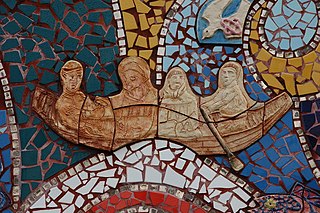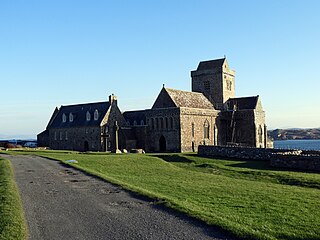Related Research Articles

Columba or Colmcille was an Irish abbot and missionary evangelist credited with spreading Christianity in what is today Scotland at the start of the Hiberno-Scottish mission. He founded the important abbey on Iona, which became a dominant religious and political institution in the region for centuries. He is the patron saint of Derry. He was highly regarded by both the Gaels of Dál Riata and the Picts, and is remembered today as a Catholic saint and one of the Twelve Apostles of Ireland.
Saint Drostan, also Drustan, was the founder and abbot of the monastery of Old Deer in Aberdeenshire. His relics were translated to the church at New Aberdour and his holy well lies nearby.

Saint Ciarán of Clonmacnoise, supposedly born Ciarán mac an tSaeir, was one of the Twelve Apostles of Ireland and the first abbot of Clonmacnoise. He is sometimes called Ciarán the Younger to distinguish him from the 5th-century Saint Ciarán the Elder who was bishop of Osraige. His name produced many variant spellings, including Ceran, Kieran, Queran and Queranus.

Cainnech of Aghaboe (515/16–600), also known as Saint Canice in Ireland, Saint Kenneth in Scotland, Saint Kenny and in Latin Sanctus Canicus, was an Irish abbot, monastic founder, priest and missionary during the early medieval period. Cainnech is one of the Twelve Apostles of Ireland and preached Christianity across Ireland and to the Picts in Scotland. He wrote a commentary on the Gospels, which for centuries was known as the Glas-Choinnigh or Kenneth's Lock or the Chain of Cainnech.

Saint Comgall, an early Irish saint, was the founder and abbot of the great Irish monastery at Bangor in Ireland.

Iona Abbey is an abbey located on the island of Iona, just off the Isle of Mull on the West Coast of Scotland.

A coarb, from the Old Irish comarbae, meaning "heir" or "successor", was a distinctive office of the medieval church among the Gaels of Ireland and Scotland. In this period coarb appears interchangeable with "erenach", denoting the episcopally nominated lay guardian of a parish church and headman of the family in hereditary occupation of church lands. The coarb, however, often had charge of a church which had held comparatively high rank in pre‐Norman Ireland, or one still possessed of relatively extensive termon lands.
Lasrén mac Feradaig or Lasrén of Iona was an Irish monk and the third abbot of Iona (c.600-605), in succession to Baíthéne. Lasrén worked during the abbacy of St Columba and administered the monastery of Durrow for the saint in the years before attaining Iona. Like Baíthéne before him, he was a kinsman of Columba from the royal dynasty of the Cenél Conaill. His father, Feradach meaning 'woodsman', was a cousin of the saint.
Adomnán or Adamnán of Iona, also known as Eunan, was an abbot of Iona Abbey (r. 679–704), hagiographer, statesman, canon jurist, and saint. He was the author of the Life of Columba, probably written between 697 and 700. This biography is by far the most important surviving work written in early-medieval Scotland, and is a vital source for our knowledge of the Picts, and an insight into the life of Iona and the early-medieval Gaelic monk.
Dúnchad mac Cinn Fáelad was the eleventh abbot of Iona (707–717). He was the son of Cenn Fáelad, and grandson of Máel Coba, of the Cenél Conaill. While most early abbots of Iona were members of Cenél Conaill they came from minor branches of the kindred, but Dúnchad came from the ruling line, grandson of one High King of Ireland and the nephew of two others, Cellach and Conall.

The Abbot of Iona was the head of Iona Abbey during the Middle Ages and the leader of the monastic community of Iona, as well as the overlord of scores of monasteries in both Scotland and Ireland, including Durrow, Kells and, until the Synod of Whitby, Lindisfarne. It was one of the most prestigious clerical positions in Dark Age Europe, and was visited by kings and bishops of the Picts, Franks and English. The Ionan abbots also had the status of Comarba of Colum Cille, i.e. the successors of that Saint, Columba.
Christianity in Medieval Scotland includes all aspects of Christianity in the modern borders of Scotland in the Middle Ages. Christianity was probably introduced to what is now Lowland Scotland by Roman soldiers stationed in the north of the province of Britannia. After the collapse of Roman authority in the fifth century, Christianity is presumed to have survived among the British enclaves in the south of what is now Scotland, but retreated as the pagan Anglo-Saxons advanced. Scotland was largely converted by Irish missions associated with figures such as St Columba, from the fifth to the seventh centuries. These missions founded monastic institutions and collegiate churches that served large areas. Scholars have identified a distinctive form of Celtic Christianity, in which abbots were more significant than bishops, attitudes to clerical celibacy were more relaxed and there were significant differences in practice with Roman Christianity, particularly the form of tonsure and the method of calculating Easter, although most of these issues had been resolved by the mid-seventh century. After the reconversion of Scandinavian Scotland in the tenth century, Christianity under papal authority was the dominant religion of the kingdom.
Saint Fintán, or Munnu is one of the saints of Ireland and Britain who served in Ireland and Scotland being the founder and abbot of the abbey at Teach-Mhunn - The House of Saint Munn - where his bed may be visited is a pilgrimage site; today Taghmon is in the County Wexford, in the province of Leinster Ireland. In Scotland, he is venerated as the patron saint of Clan Campbell.
Ernan is the name of four Irish saints.
There is archaeological evidence of insular monasticism as early as the mid 5th century, influenced by establishments in Gaul such as the monastery of Martin of Tours at Marmoutier, the abbey established by Honoratus at Lérins; and that of Germanus at Auxerre. Many Irish monks studied at Candida Casa near Whithorn in what is now Galloway in Scotland.

Saint Brendan of Birr was one of the early Irish monastic saints. He was a monk and later an abbot, of the 6th century. He is known as "St Brendan the Elder" to distinguish him from his contemporary and friend St Brendan the Navigator of Clonfert. He was one of the Twelve Apostles of Ireland, a friend and disciple of Saint Columba.
Events from the 7th century in Ireland.

Aidan of Lindisfarne was an Irish monk and missionary credited with converting the Anglo-Saxons to Christianity in Northumbria. He founded a monastic cathedral on the island of Lindisfarne, known as Lindisfarne Priory, served as its first bishop, and travelled ceaselessly throughout the countryside, spreading the gospel to both the Anglo-Saxon nobility and the socially disenfranchised.
Baithéne mac Brénaind was an Irish monk, one of Saint Columba's followers who accompanied him to Scotland around 563, and was the first successor of the abbacy of Iona. The Annals of Tigernach record his birth in 534, and his death was likely between 596 and 598 according also to the Annals of Ulster. Irish genealogical records indicate him to be the "son of Brendan, son of Fergus, son of Conall Gulban, son of Niall Noígiallach", thus being a member of the Cenél Conaill branch of the Northern Uí Néill, as the abbots of Iona following the death of Columba often were.
Saints and animal/plant life. A number of Christian saints have anecdotes and stories about them in relation to animals or plants. In some cases they appeared to possess miraculous powers to speak with animals.
References
- 1 2 3 "St. Blathmac". Catholic Encyclopedia .
- ↑ "A Folklore Survey of County Clare by Thomas Johnson Westropp" . Retrieved 11 February 2016.
- ↑ "Catholic dictionary" . Retrieved 11 February 2016.
- 1 2 Breen, Aidan. "Blathmac", Dictionary of Irish Biography
- ↑ The Cyclopedia of Biblical, Theological, and Ecclesiastical Literature. (James Strong and John McClintock, eds.); Harper and Brothers; NY; 1880
 This article incorporates text from this source, which is in the public domain .
This article incorporates text from this source, which is in the public domain . - ↑ Forte, Angelo; Oram, Richard; Pedersen, Frederik (2005). Viking Empires. Cambridge: Cambridge University Press. pp. 55–58. ISBN 9780521829922.